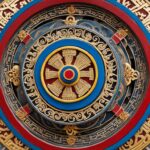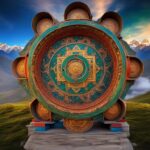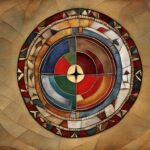Prayer wheels, an integral part of Tibetan Buddhism, are fascinating sacred objects used in various religious traditions and spiritual practices. These cylindrical devices hold deep symbolism and serve as meditative tools in Buddhist rituals. With a rich history dating back to the 9th century, prayer wheels offer practitioners a path to spiritual transformation and enlightenment.
Key Takeaways:
- Prayer wheels are cylindrical devices associated with Tibetan Buddhism and are used in religious traditions and spiritual practices.
- These sacred objects hold symbolic significance and are utilized as meditative tools in Buddhist rituals.
- The history of prayer wheels dates back to the 9th century, possibly originating from Chinese book repositories.
- There are various types of prayer wheels, including human-powered and non-human-powered versions.
- Prayer wheels, whether in Buddhism or Christianity, offer avenues for deepening faith and enhancing one’s relationship with the divine.
What are Prayer Wheels in Buddhism?
In Buddhism, prayer wheels are cylindrical devices that hold great spiritual significance. These wheels are closely associated with Tibetan Buddhism and are used as tools for devotion and meditation. Made of materials such as metal, wood, or cloth, prayer wheels feature Buddhist mantras inscribed on paper, metal plates, or embossed into the object. The outer part of the wheel often includes auspicious symbols like lotus flowers or golden fish.
The act of spinning the prayer wheel in a clockwise direction is believed to accumulate merit and blessings. The Mani wheel is the most popular type of prayer wheel used by Buddhists in Tibet, Bhutan, Mongolia, and northern India. Each rotation of the wheel is believed to increase the power of the mantra written on it, further enhancing its spiritual benefits.
Prayer wheels play an essential role in Tibetan Buddhist rituals and practices. They serve as physical representations of the Buddhist teachings and help practitioners deepen their spiritual connection. The repetitive motion of spinning the wheel aids in cultivating mindfulness and focus, allowing individuals to enter a meditative state. By using prayer wheels, Buddhists aim to cultivate qualities such as compassion, peace, and understanding.
| Type of Prayer Wheel | Description |
|---|---|
| Mani Wheel | The most common type of prayer wheel used in Tibetan Buddhism. It contains the mantra “Om Mani Padme Hum” and is spun to accumulate merit and blessings. |
| Human-Powered Prayer Wheels | These prayer wheels can be spun manually by hand. They vary in size, from handheld personal prayer wheels to larger ones found in temples. |
| Non-Human-Powered Prayer Wheels | These prayer wheels are often found in temples and operate using flowing water or wind to spin the wheel. They can be intricately designed and are commonly seen in Tibetan Buddhist temples. |
History of the Buddhist Prayer Wheel
The Buddhist prayer wheel has a rich history that dates back to the 9th century. Although the exact origins are uncertain, one theory suggests a connection to Chinese octagonal book repositories of that time period. These repositories were used to store sacred Buddhist texts and had a unique design with a wooden handle for spinning. It is believed that this design influenced the development of the prayer wheel as we know it today.
The prayer wheel’s evolution from book repositories to its current form is an intriguing aspect of its history. This transition highlights the significance of written texts and their role in Buddhist practices. The adoption of the prayer wheel allowed for a more dynamic and interactive engagement with the sacred teachings.
The Origins at a Glance
| Time Period | Development |
|---|---|
| 9th century | Possible origins tied to Chinese octagonal book repositories |
| Evolution | Transition from book repositories to the prayer wheel |
“The prayer wheel’s adaptation from book repositories showcases the importance of written texts in Buddhist practices and the desire for a more interactive engagement with the teachings.”
Throughout history, the Buddhist prayer wheel has become a powerful and profound symbol within Tibetan Buddhism and other regions where the tradition is practiced. Its humble beginnings in ancient repositories have transformed into a revered object of devotion and spiritual transformation.
Types of Buddhist Prayer Wheels
There are various types of Buddhist prayer wheels, each with its own unique characteristics and purpose. These prayer wheels can be categorized into human-powered and non-human-powered versions. Let’s explore each type in detail:
Human-Powered Prayer Wheels
Human-powered prayer wheels are the most common type and have been used by practitioners for centuries. These prayer wheels are designed to be spun manually by hand. They come in different sizes, ranging from handheld personal prayer wheels to larger wheels found in temples and monasteries. The smaller handheld prayer wheels are convenient for individual practice, while the larger ones can be spun by multiple individuals to generate greater merit and blessings.
Non-Human-Powered Prayer Wheels
Non-human-powered prayer wheels operate with the help of natural elements such as flowing water or wind. These prayer wheels are often found in temples and monasteries, where they are strategically placed to catch the natural flow of water or wind. The movement of the water or wind spins the prayer wheel, generating merit and blessings without the need for human intervention. One popular type of non-human-powered prayer wheel is the Tibetan prayer wheel, known for its elaborate designs and symbolism.
Tibetan Prayer Wheels
Tibetan prayer wheels are a prominent type of non-human-powered prayer wheel. They are known for their ornate craftsmanship and intricate designs. These prayer wheels often feature precious metals, gemstones, and intricate carvings. Tibetan prayer wheels are regarded as sacred objects in Tibetan Buddhism and are commonly found in Tibetan monasteries and temples. They hold significant importance in Tibetan culture and spiritual practices, serving as a visual representation of Buddhist teachings and a means of accumulating merit and blessings.
| Type of Prayer Wheel | Description |
|---|---|
| Human-Powered | Spun manually by hand, comes in various sizes |
| Non-Human-Powered | Operates with the help of natural elements like flowing water or wind |
| Tibetan | Elaborate designs, often made with precious metals and gemstones |
The various types of Buddhist prayer wheels provide practitioners with different opportunities for spiritual engagement and merit accumulation. Whether it be through the manual spinning of human-powered prayer wheels, or the awe-inspiring symbolism of non-human-powered Tibetan prayer wheels, each type offers a unique experience in the practice of Tibetan Buddhism.
Christian Prayer Wheel and the Sacred Hour of Prayer
While prayer wheels are commonly associated with Eastern religions, there is also a Christian adaptation known as the Christian Prayer Wheel. This spiritual tool blends elements of Christian contemplative practices with the concept of the prayer wheel. The Christian Prayer Wheel typically consists of a circular wheel with Christian prayers or verses inscribed on it. It serves as a reminder to set aside dedicated moments for prayer and reflection throughout the day, aligning with the sacred hours of prayer observed in Christian traditions.
The Christian Prayer Wheel is used to deepen one’s relationship with God and is meant to complement traditional forms of prayer. Just like the Buddhist prayer wheels, the Christian Prayer Wheel provides a structured approach to prayer, helping individuals stay focused and intentional in their communication with the divine. By spinning the Christian Prayer Wheel clockwise, believers engage in a meditative practice that facilitates a deeper connection with their faith.
The Christian Prayer Wheel serves as a visual and tactile aid for Christians to incorporate into their spiritual routines. It provides a physical representation of the sacred hour of prayer, reminding believers to pause and dedicate themselves to prayer at specific times throughout the day. This practice not only helps individuals develop a disciplined prayer life but also fosters a sense of mindfulness and spiritual attentiveness.

Table: Comparison between Buddhist Prayer Wheels and Christian Prayer Wheel
| Buddhist Prayer Wheels | Christian Prayer Wheel |
|---|---|
| Associated with Tibetan Buddhism | Adaptation in Christianity |
| Contain Buddhist mantras | Include Christian prayers or verses |
| Spun clockwise to accumulate merit and blessings | Spun clockwise to engage in disciplined prayer |
| Considered as a spiritual tool for transformation | Used to deepen one’s relationship with God |
| Types: human-powered and non-human-powered versions | A single version used as a reminder for structured prayer |
Conclusion
The prayer wheel traditions, whether in Buddhism or Christianity, hold great significance in spiritual practices. These ancient traditions provide individuals with tangible tools to deepen their faith and strengthen their relationship with God. Whether spinning the prayer wheel or observing the sacred hours of prayer, these practices offer unique opportunities for spiritual exploration and growth.
Prayer Wheel Traditions:
In Buddhism, prayer wheels such as the Mani wheel serve as meditative tools, helping practitioners cultivate peace, compassion, and understanding. By spinning these wheels in a clockwise direction, Buddhists believe they can accumulate merit and blessings. Tibetan Buddhist temples often feature non-human-powered prayer wheels, driven by flowing water or wind, creating an atmosphere of serenity and devotion.
Similarly, Christianity has adapted the concept with the Christian Prayer Wheel. This spiritual tool combines Christian contemplative practices with the idea of a prayer wheel. The Christian Prayer Wheel encourages believers to set aside dedicated moments throughout the day, aligning with the sacred hours of prayer observed in Christian traditions. It serves as a tangible reminder to deepen one’s relationship with God through structured prayer and reflection.
Spiritual Growth and Connection:
Engaging in prayer wheel traditions, whether in Buddhism or Christianity, helps individuals develop a regular spiritual practice. These practices foster a state of mindfulness and connection to the divine, allowing one to experience a deepening of faith and a stronger relationship with God. By incorporating prayer wheels or observing the sacred hours of prayer, individuals can explore and nurture their spirituality in a meaningful way.
As spiritual seekers, we can embrace these traditions and use them as powerful tools on our paths towards self-discovery and enlightenment. The prayer wheel traditions, in their various forms, invite us to engage in regular prayer, contemplation, and reflection, ultimately leading to a greater understanding of ourselves and the divine.
FAQ
What are prayer wheels in Buddhism?
Prayer wheels in Buddhism are cylindrical devices that contain Buddhist mantras. They are spun in a clockwise direction to accumulate merit and blessings.
What is the history of the Buddhist prayer wheel?
The exact origins of the Buddhist prayer wheel are uncertain, but it is believed to have emerged around the 9th century. One theory suggests that its origin can be traced back to Chinese octagonal book repositories from that time period.
What are the types of Buddhist prayer wheels?
There are human-powered and non-human-powered versions of prayer wheels. Human-powered prayer wheels include handheld personal prayer wheels and larger wheels that can be spun manually. Non-human-powered prayer wheels are often found in temples and operate with the help of flowing water or wind.
What is the Christian Prayer Wheel?
The Christian Prayer Wheel is a spiritual tool that blends elements of Christian contemplative practices with the concept of the prayer wheel. It consists of a circular wheel with Christian prayers or verses inscribed on it and is used to deepen one’s relationship with God.









